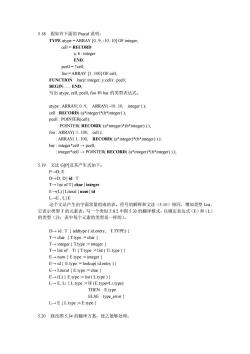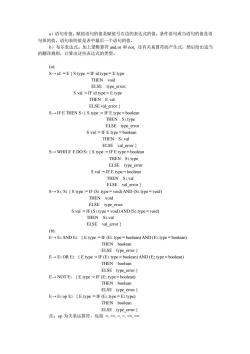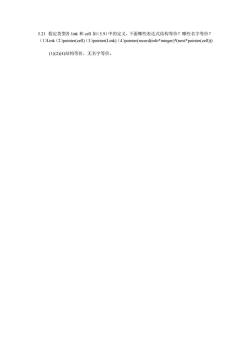新疆大学:《编译原理》课程教学资源(习题解答)Chapter5_2

5.18假如有下面的Pascal说明: TYPE atype=ARRAY[.-10.10]OF integer a,b:integer END: pcell=fcell: foo=ARRAY [1.100]OF cell FUNCTION ar(rinteger.y:cell):pcell. BEGIN END 写出aype,cell,pcel,foo和bar的类型表达式。 atype:ARRAY(0.9.ARRAY(-10.10.integer ) cell:RECORD(a*integer)产(b*integer)方 pell:POINTER() POINTER(RECORD((ainteger)(binteger))): foo:ARRAY(1.100,cell ) ARRAY(1.100.RECORD((a*integer)*(b*integer))): :integer"cellPOINTER(RECORD((a*integer)(b*integer))) 5.19文法GP1及其产生式如下: P→D:E DD:DIid:T E-(L)|Literal num id L→E,LE 这个文法产生由字面常量组成的表。符号的解释和文法(5.10)相同,增加类型L, 它表示类型T的元素表。写一个类似5.82中图5.33的翻译模式,以确定表达式(E)和(L) 的类型(注:表中每个元素的类型是一样的)。 Did:T{addtype (id.enery,T.TYPE) T-char T.type :char T-integer Ttvpe:=integer Tlist of TTtype:=list (TLtype E→num{E.type nteger E-id E.type:=lookup(id.entry)) E-Literal E.type:=char E-(L){E.type:=list (L.type)) LE.Li{L.type:=IF(E.type-Litype) THEN E.type ELSE type_error L→E{L.type=E.type; 5.20修改图5.34的翻译方案,使之能够处理:
5.18 假如有下面的 Pascal 说明: TYPE atype = ARRAY [0.9, -10.10] OF integer; cell = RECORD a, b : integer END; pcell = ↑cell; foo = ARRAY [1.100] OF cell; FUNCTION bar(r:integer; y:cell) : pcell; BEGIN.END; 写出 atype, cell, pcell, foo 和 bar 的类型表达式。 atype : ARRAY( 0.9, ARRAY( -10.10, integer ) ); cell : RECORD( (a*integer)*(b*integer) ); pcell : POINTER(cell); : POINTER( RECORD( (a*integer)*(b*integer) ) ); foo : ARRAY( 1.100, cell ); : ARRAY( 1.100, RECORD( (a*integer)*(b*integer) ) ); bar : integer*cell → pcell; : integer*cell → POINTER( RECORD( (a*integer)*(b*integer) ) ); 5.19 文法 G[P]及其产生式如下: P→D; E D→D; D | id : T T→ list of T | char | integer E→(L) | Literal | num | id L→E , L | E 这个文法产生由字面常量组成的表。符号的解释和文法(5.10)相同,增加类型 List, 它表示类型 T 的元素表。写一个类似 5.8.2 中图 5.33 的翻译模式,以确定表达式(E)和(L) 的类型(注:表中每个元素的类型是一样的)。 D→ id : T { addtype ( id.enery, T.TYPE) } T→ char { T.type := char } T→ integer { T.type := integer } T→ list of T1 { T.type := list ( T1.type ) } E→ num { E.type := integer } E→ id { E.type := lookup( id.entry ) } E→ Literal { E.type := char } E→ (L) { E.type := list ( L.type ) } L→ E, L1 { L.type := IF (E.type=L1.type) THEN E.type ELSE type_error } L→ E { L.type := E.type } 5.20 修改图 5.34 的翻译方案,使之能够处理:

)语句有值。赋值语句的值是赋值号右边的表达式的值。条件语句或当语句的值是语 句体的值,语句表的值是表中最后一个语句的值。 B) 布尔表达式。加上逻辑算符and,or和not,还有关系算符的产生式,然后给出适当 的翻译规则,计算出这些表达式的类型。 (a: Sid:-E(S.type:=IF id.type=E.type THE void ELSE type_error; S.val:=IF id.type=E.type THEN E.val ELSEval_error S-IF E THEN S(S.type=IF E.type-boolean THEN S1.type ELSE type error S.val :=IF E.type=boolean THEN SLval S-WHILE EDOS(S.type=IF E.type=boolean THEN S1.type ELSE type error S.val :=IF E.type=boolean THEN Sval ELSE S-S1;S2{S.type:=IF(S1.type-void)AND(S2.type-void) THEN void ELSE type_error S.val:=IF(S1.type d)AND(S2.type=void) THEN S2.val ELSE val error (b: E-Ei AND E2 E.type:=IF(E1.type=boolean)AND(E2.type=boolean) THEN boolean ELSE type EOR EEype:-1F (E.typebocan)AND (Epeboocm) THEN boolean ELSE type error E-NOT EE.type:=IF (E1.type=boolean) THEN boolear ELSE type_error E-E1op E2 (E.type:=IF(E1.type=E2.type) THEN boolean ELSE type error 注:叩为关系运算符,包括二,⊙,<>,<
a)语句有值。赋值语句的值是赋值号右边的表达式的值。条件语句或当语句的值是语 句体的值,语句表的值是表中最后一个语句的值。 b)布尔表达式。加上逻辑算符 and,or 和 not, 还有关系算符的产生式,然后给出适当 的翻译规则,计算出这些表达式的类型。 (a): S→ id := E { S.type := IF id.type = E.type THEN void ELSE type_error; S.val := IF id.type = E.type THEN E.val ELSE val_error } S→ IF E THEN S1 { S.type := IF E.type = boolean THEN S1.type ELSE type_error S.val := IF E.type = boolean THEN S1.val ELSE val_error } S→ WHILE E DO S1 { S.type := IF E.type = boolean THEN S1.type ELSE type_error S.val := IF E.type = boolean THEN S1.val ELSE val_error } S→ S1; S2 { S.type := IF (S1.type = void) AND (S2.type = void) THEN void ELSE type_error S.val := IF (S1.type = void) AND (S2.type = void) THEN S2.val ELSE val_error } (b): E→ E1 AND E2 { E.type := IF (E1.type = boolean) AND (E2.type = boolean) THEN boolean ELSE type_error } E→ E1 OR E2 { E.type := IF (E1.type = boolean) AND (E2.type = boolean) THEN boolean ELSE type_error } E→ NOT E1 { E.type := IF (E1.type = boolean) THEN boolean ELSE type_error } E→ E1 op E2 { E.type := IF (E1.type = E2.type) THEN boolean ELSE type_error } 注:op 为关系运算符,包括 =, <>, , =

5.21假定类型各1ik和cell如(5.9)中的定义,下面哪些表达式结构等价?哪些名字等价? (1)Link (2pointer(cell)(3)pointer(Link)(4)pointer(record(info*integer)(next*pointer(cell)) (1(2(4)结构等价,无名字等价
5.21 假定类型各 link 和 cell 如(5.9)中的定义,下面哪些表达式结构等价?哪些名字等价? (1)Link(2)pointer(cell)(3)pointer(Link)(4)pointer(record(info*integer)*(next*pointer(cell))) (1)(2)(4)结构等价,无名字等价
按次数下载不扣除下载券;
注册用户24小时内重复下载只扣除一次;
顺序:VIP每日次数-->可用次数-->下载券;
- 新疆大学:《编译原理》课程教学资源(习题解答)Chapter5_1.doc
- 新疆大学:《编译原理》课程教学资源(习题解答)Chapter4_3.doc
- 新疆大学:《编译原理》课程教学资源(习题解答)Chapter4_2.doc
- 新疆大学:《编译原理》课程教学资源(习题解答)Chapter4_1.doc
- 新疆大学:《编译原理》课程教学资源(习题解答)Chapter3.doc
- 新疆大学:《编译原理》课程教学资源(习题解答)Chapter2.doc
- 新疆大学:《编译原理》课程教学资源(习题解答)Chapter1.doc
- 新疆大学:《编译原理》课程教学资源(教案讲义)39-48.doc
- 新疆大学:《编译原理》课程教学资源(教案讲义)27-38.doc
- 新疆大学:《编译原理》课程教学资源(教案讲义)27-36.doc
- 新疆大学:《编译原理》课程教学资源(教案讲义)19-26.doc
- 新疆大学:《编译原理》课程教学资源(教案讲义)11-18.doc
- 新疆大学:《编译原理》课程教学资源(教案讲义)01-10.doc
- 新疆大学:《编译原理》课程教学实验指导.docx
- 新疆大学:《编译原理》课程教学大纲 Compliers Principles(负责人:吴晓红).pdf
- 新疆大学:《C语言程序设计》课程授课教案(实验讲义,负责人:田生伟).doc
- 新疆大学:《C语言程序设计》课程授课教案(课件讲稿,共十章).pdf
- 新疆大学:《C语言程序设计》课程教学大纲 C Language Programming.pdf
- 福建交通职业技术学院:《计算机网络基础》课程教学课件(PPT讲稿)第10章 网络安全.ppt
- 福建交通职业技术学院:《计算机网络基础》课程教学课件(PPT讲稿)第9章 接入互联网.ppt
- 新疆大学:《编译原理》课程教学资源(习题解答)Chapter6.doc
- 新疆大学:《编译原理》课程教学资源(习题解答)Chapter7.doc
- 《编译原理》习题答案(清华第二版)第01章 引论.pdf
- 《编译原理》习题答案(清华第二版)第03章 文法和语言.pdf
- 《编译原理》习题答案(清华第二版)第04章 词法分析.pdf
- 《编译原理》习题答案(清华第二版)第05章 自顶向下语法分析方法.pdf
- 《编译原理》习题答案(清华第二版)第06章 自底向上优先分析.pdf
- 《编译原理》习题答案(清华第二版)第2章 PL0编译程序的实现.pdf
- 《编译原理》课程教学资源(PPT课件,完整讲稿,共十章).pptx
- 新疆大学:《软件工程》课程教学课件(讲稿)第五讲 软件设计(主讲:张琳琳).pdf
- 《软件工程》课程参考资料(软件工程思想)第一章 软件工程基本观念.doc
- 《软件工程》课程参考资料(软件工程思想)第七章 测试与改错.doc
- 《软件工程》课程参考资料(软件工程思想)第三章 项目计划与质量管理.doc
- 《软件工程》课程参考资料(软件工程思想)第二章 程序员与程序经理.doc
- 《软件工程》课程参考资料(软件工程思想)第五章 系 统设计.doc
- 《软件工程》课程参考资料(软件工程思想)第八章 维护与再生工程.doc
- 《软件工程》课程参考资料(软件工程思想)第六章 C++面向对象程序设计.doc
- 《软件工程》课程参考资料(软件工程思想)第四章 可行性分析与需求分析.doc
- 新疆大学:《软件工程》课程教学课件(讲稿)第七讲 软件维护.pdf
- 新疆大学:《软件工程》课程教学课件(讲稿)第九讲 面向对象分析.pdf
